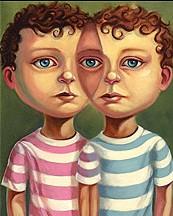Twin studies prove homosexuality is not genetic
Taken from Orthodoxy Today. By Mark Ellis, June 24, 2013

Eight major studies of identical twins in Australia, the U.S., and Scandinavia during the last two decades all arrive at the same conclusion: gays were not born that way.
“At best genetics is a minor factor,” says Dr. Neil Whitehead, PhD. Whitehead worked for the New Zealand government as a scientific researcher for 24 years, then spent four years working for the United Nations and International Atomic Energy Agency.
Identical twins have the same genes or DNA. They are nurtured in equal prenatal conditions. If homosexuality is caused by genetics or prenatal conditions and one twin is gay, the co-twin should also be gay.
But the studies reveal something else, says Dr. Whitehead. “If an identical twin has same-sex attraction the chances the co-twin has it are only about 11% for men and 14% for women.”
“No-one is born gay. The predominant things that create homosexuality in one identical twin and not in the other have to be post-birth factors.”
For example, one twin might have exposure to pornography or sexual abuse, but not the other. One twin may interpret and respond to their family or classroom environment differently than the other. “These individual and idiosyncratic responses to random events and to common environmental factors predominate,” he says.
“Twin registers are the foundation of modern twin studies. They are now very large, and exist in many countries. A gigantic European twin register with a projected 600,000 members is being organized, but one of the largest in use is in Australia, with more than 25,000 twins on the books.”
A significant twin study among adolescents shows an even weaker genetic correlation. In 2002 Bearman and Brueckner studied tens of thousands of adolescent students in the U.S. The same-sex attraction concordance between identical twins was only 7.7% for males and 5.3% for females—lower than the 11% and 14% in the Australian study by Bailey et al conducted in 2000.
In the identical twin studies, Dr. Whitehead has been struck by how fluid and changeable sexual identity can be.
“Neutral academic surveys show there is substantial change. About half of the homosexual/bisexual population (in a non-therapeutic environment) moves towards heterosexuality over a lifetime. About 3% of the present heterosexual population once firmly believed themselves to be homosexual or bisexual.”
“These changes are not therapeutically induced, but happen ‘naturally’ in life, some very quickly. Most changes in sexual orientation are towards exclusive heterosexuality.”
Numbers of people who have changed towards exclusive heterosexuality are greater than current numbers of bisexuals and homosexuals combined. In other words, ex-gays outnumber actual gays.
“They found that from 16 to 17-years-old, if a person had a romantic attraction to the same sex, almost all had switched one year later.”
“The authors were pro-gay and they commented that the only stability was among the heterosexuals, who stayed the same year after year. Adolescents are a special case—generally changing their attractions from year to year.”
[...] misconceptions persist in the popular culture [...] that homosexuality is genetic – so hard-wired into one’s identity that it can’t be changed. “The academics who work in the field are not happy with the portrayals by the media on the subject,” Dr. Whitehead notes. “But they prefer to stick with their academic research and not get involved in the activist side.”
Read the entire article here
Category
Health, Sexual perversion- 932 reads









